Craving the best homemade Filipino dinuguan? After years of ordering this silky-smooth pork blood stew from a stall at Enterprise Center's food court during my graveyard shifts at Convergys Makati (fellow BPO warriors, you know that spot!), I finally learned how to recreate that exact same rich, garlicky goodness at home.
Every spoonful of this dinuguan recipe takes me back to those 3AM breaks, when a steaming bowl of dinuguan with puto was all I needed to power through until morning. As someone who's gone from a daily customer to now making this dish for my own family's Sunday lunch, this recipe nails that perfect balance of tangy and savory that we Pinoys love.
This foolproof authentic dinuguan recipe will give you that same comforting flavor that kept me going through countless night shifts.
Jump to:
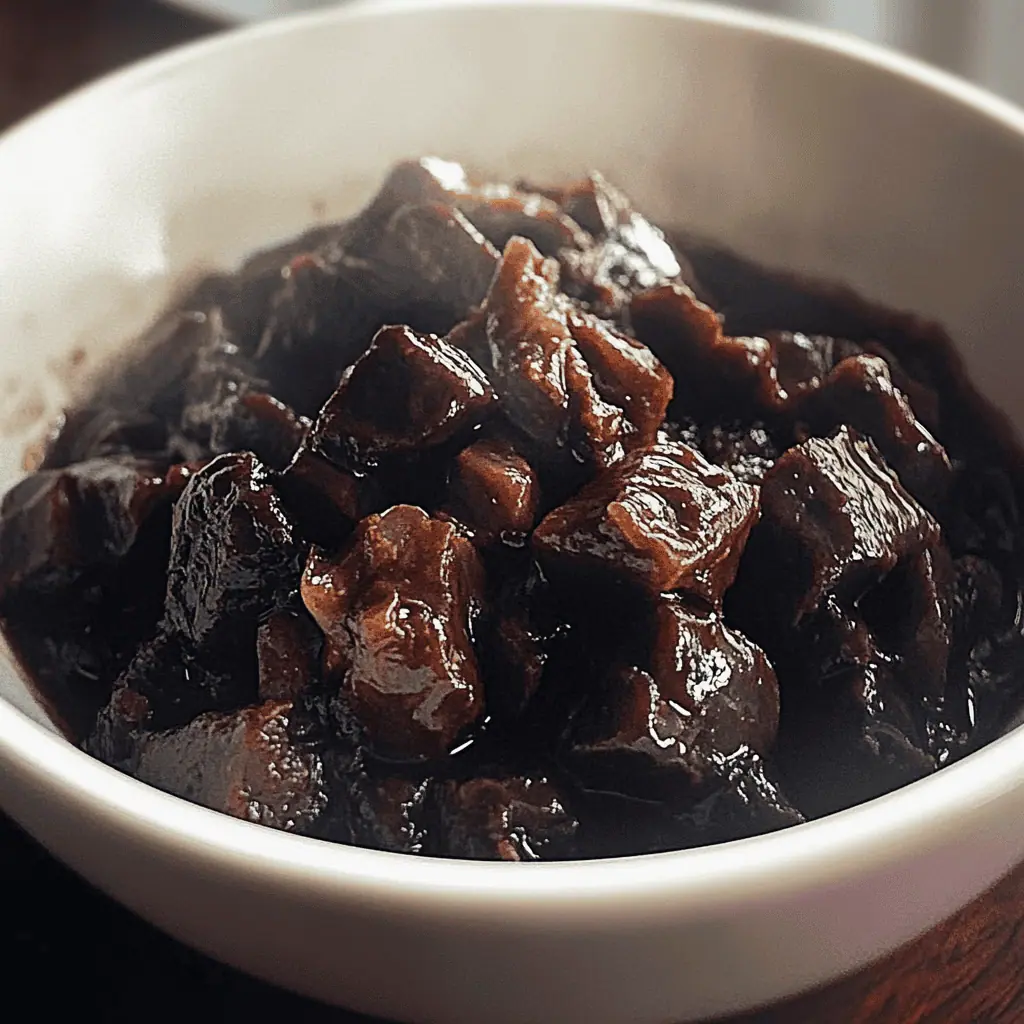
Why You'll Love This Recipe
- Authentic Taste: Traditional flavors passed down through generations
- Detailed Instructions: Step-by-step guidance with temperature controls
- Complete Guide: Includes troubleshooting, variations, and Lola's secret tips
- Bilingual Instructions: Filipino translations for complex terms
- Versatile: Can be made with different cuts of pork
- Make-Ahead Friendly: Perfect for meal prep and special occasions
Ingredients
This authentic dinuguan recipe uses carefully selected ingredients that work together perfectly. Pork belly provides richness with its ideal fat-to-meat ratio, while fresh pork blood creates the distinctive velvety texture. Vinegar serves three crucial purposes: it preserves the blood, balances its richness, and adds the signature tangy flavor that cuts through the savory elements.
Garlic, ginger, and onions form the aromatic foundation, while fish sauce adds depth without overpowering. The finger chilies introduce gentle heat and color contrast, and brown sugar rounds out the flavors by subtly balancing the acidity.
Together, these ingredients create the perfect harmony of flavors that makes traditional dinuguan so beloved in Filipino cuisine.
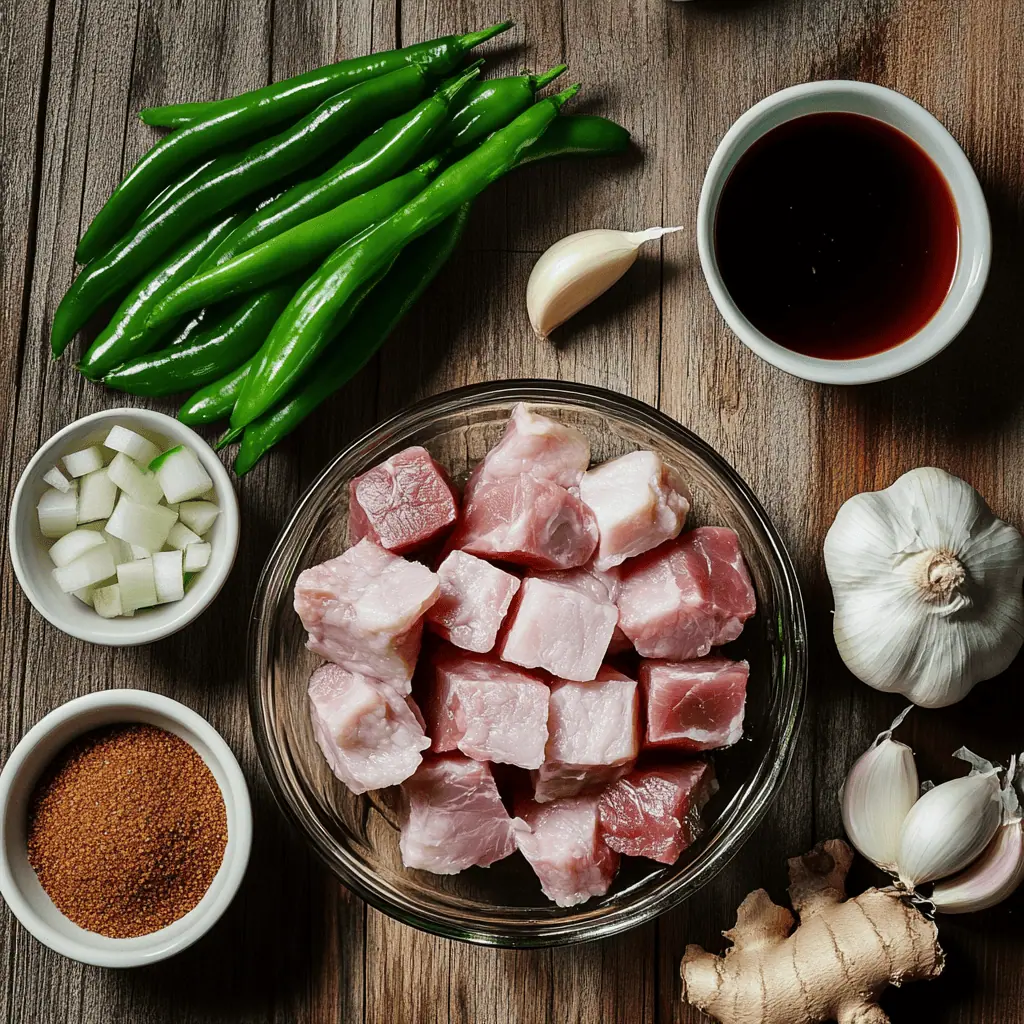
For the Stew Base:
- 2 pounds pork belly (liempo), cut into ½-inch cubes
- 10 ounces fresh pork blood (dugo ng baboy)
- 1 cup vinegar (suka)
- 1 large onion (sibuyas), finely chopped
- 4 cloves garlic (bawang), minced
- 1 thumb-sized ginger (luya), minced
- 1 tablespoon fish sauce (patis)
- 1 cup water (tubig)
- 1 tablespoon brown sugar (asukal na pula)
- 2-3 finger chilies/long green chilies (siling haba)
- Salt and pepper to taste
- 1 tablespoon cooking oil
Optional Traditional Additions:
- Pork ears (tenga)
- Intestines (bituka)
- Heart (puso)
- Kidney (bato)
Equipment
- Large Heavy-Bottomed Pot: Essential for even heat distribution and preventing scorching of the blood mixture
- Sharp Chef's Knife: For cutting pork into uniform pieces
- Cutting Board: Preferably with a groove to catch juices
- Mixing Bowls: Multiple sizes for preparing ingredients
- Wooden Spoon or Silicone Spatula: For gentle stirring that won't break up blood curds
- Measuring Cups and Spoons: For accurate ingredient portions
- Meat Thermometer: To ensure pork reaches safe temperature (165°F/74°C)
- Airtight Containers: For storing leftovers properly
- Kitchen Timer: To track cooking stages for perfect results
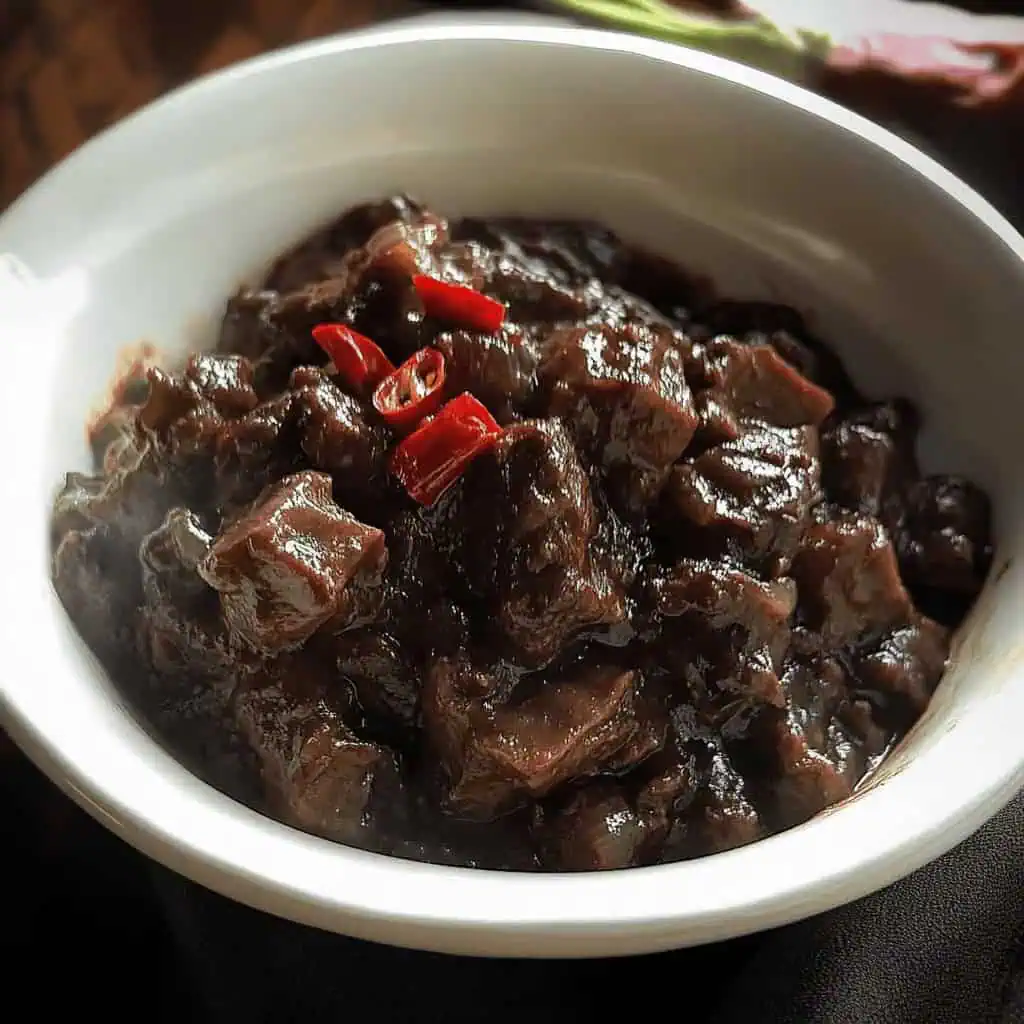
How To Make
- Preparation: Gather all ingredients and equipment. Ensure pork blood is fresh and kept cold at 40°F (4°C).
- Stabilize the Blood: Combine fresh pork blood with 2 tablespoons of vinegar in a bowl. Mix gently and refrigerate immediately. This prevents coagulation and preserves freshness.
- Build the Flavor Base: Heat a large heavy-bottomed pot over medium heat (300°F/149°C). Add cooking oil, then sauté finely chopped onions until translucent and soft, about 5 minutes.
- Add Aromatics: Incorporate minced garlic and ginger. Cook until fragrant, about 2 minutes, stirring occasionally to prevent burning.
- Brown the Meat: Increase heat to medium-high (325°F/163°C). Add pork belly cubes and cook until browned on all sides, approximately 8-10 minutes.
- Season: Pour in fish sauce (patis) and cook for another 2 minutes, stirring to coat the meat evenly.
- Critical Vinegar Step: Add the remaining vinegar to the pot. DO NOT STIR for 3-5 minutes. Allow it to boil and cook off the harsh vinegar taste. This step is crucial for authentic flavor development.
- Build the Stew: Add one cup of water, bring to a boil, then reduce heat to low (185°F/85°C). Cover and simmer for 20 minutes, or until the pork becomes tender.
- Add the Blood: Remove blood mixture from refrigerator and let it come to room temperature. Once meat is tender, slowly pour in the blood while gently stirring. Keep heat low and stir constantly but gently to prevent curdling.
- Finish the Dish: Add brown sugar and finger chilies. Simmer and stir gently for about 10 minutes, or until the sauce thickens to your desired consistency.
- Final Seasoning: Taste and adjust with salt and pepper as needed. The sauce should be smooth and velvety, with a balanced tangy-savory flavor.
- Check Doneness: Your dinuguan is ready when the sauce is thick but still flows, the meat is tender but holds its shape, and the color is a rich chocolate brown. Internal temperature should reach 165°F/74°C.
- Serve: Present hot with steamed rice or puto (rice cakes). For extra flavor, serve with calamansi on the side.

Tips from Lola's Kitchen
- Always use fresh pork blood for best results
- Pre-mixing blood with vinegar prevents clumping
- Never skip the "no stirring" step after adding vinegar
- Keep the heat low when adding blood to prevent curdling
- Adding blood gradually while stirring helps maintain a smooth texture
- For a silkier texture, strain the blood before using
- Let the stew simmer gently — aggressive boiling will break down the blood
- The sauce will continue to thicken as it cools
Substitutions
- Vinegar: Palm vinegar is traditional, but apple cider vinegar or white distilled vinegar can work as substitutes. Each provides a slightly different flavor profile.
- Pork Belly: Pork shoulder or other fatty cuts can replace belly, but the richness will vary. Leaner cuts will produce a less luxurious mouthfeel.
- Fresh Chilies: Dried chilies or chili flakes can substitute for fresh. Start with half the amount and adjust to taste.
- Fresh Blood: While fresh is strongly preferred, packaged pork blood can be used in a pinch. Ensure it's from a reputable source and mix with vinegar immediately upon opening.
- Fish Sauce: If unavailable, use salt, though you'll miss the umami depth that fish sauce provides.
- Optional Organs: Each traditional addition contributes unique texture and flavor. Feel free to use any combination based on availability and preference.
Troubleshooting
Blood Curdling
- Problem: Blood forms small lumps in the stew rather than creating a smooth sauce.
- Solution: Lower heat immediately and stir gently. If caught early, the sauce may still smooth out.
- Prevention: Ensure blood is pre-mixed with vinegar, add it to the stew gradually while stirring constantly, and keep heat very low during addition.
Too Sour
- Problem: The vinegar taste overwhelms the dish.
- Solution: Add brown sugar gradually, a teaspoon at a time, until balanced. In extreme cases, add a small amount of coconut milk.
- Prevention: Always allow vinegar to boil off during the no-stirring step, and use the correct vinegar-to-blood ratio.
Too Thick
- Problem: Stew becomes paste-like rather than flowing.
- Solution: Add warm water gradually while stirring gently until reaching desired consistency.
- Prevention: Monitor liquid ratio during cooking and don't reduce too far.
Too Watery
- Problem: Sauce won't thicken properly.
- Solution: Simmer uncovered to reduce liquid, or make a slurry with 1 teaspoon cornstarch and 2 tablespoons cold water.
- Prevention: Ensure proper blood-to-liquid ratio and adequate simmering time.
Metallic Taste
- Problem: Blood imparts an unpleasant metallic flavor.
- Solution: Add more acid (vinegar or calamansi juice) and a pinch of sugar to balance.
- Prevention: Use the freshest blood possible and ensure it's properly cooked.
Storage & Reheating
Refrigerating
- Cool completely before transferring to airtight containers
- Store for up to 3 days in the refrigerator
- Keep away from foods that might absorb odors
Freezing
- Can be frozen for up to 2 months
- Freeze in portion-sized containers
- Leave some space at the top for expansion
- Label with date and contents
Reheating
- Thaw frozen dinuguan overnight in the refrigerator
- Reheat on low heat, stirring occasionally
- Add 1-2 tablespoons of water if needed to restore consistency
- Bring to a full simmer for food safety
- Stir gently to maintain texture
- Never refreeze previously frozen dinuguan
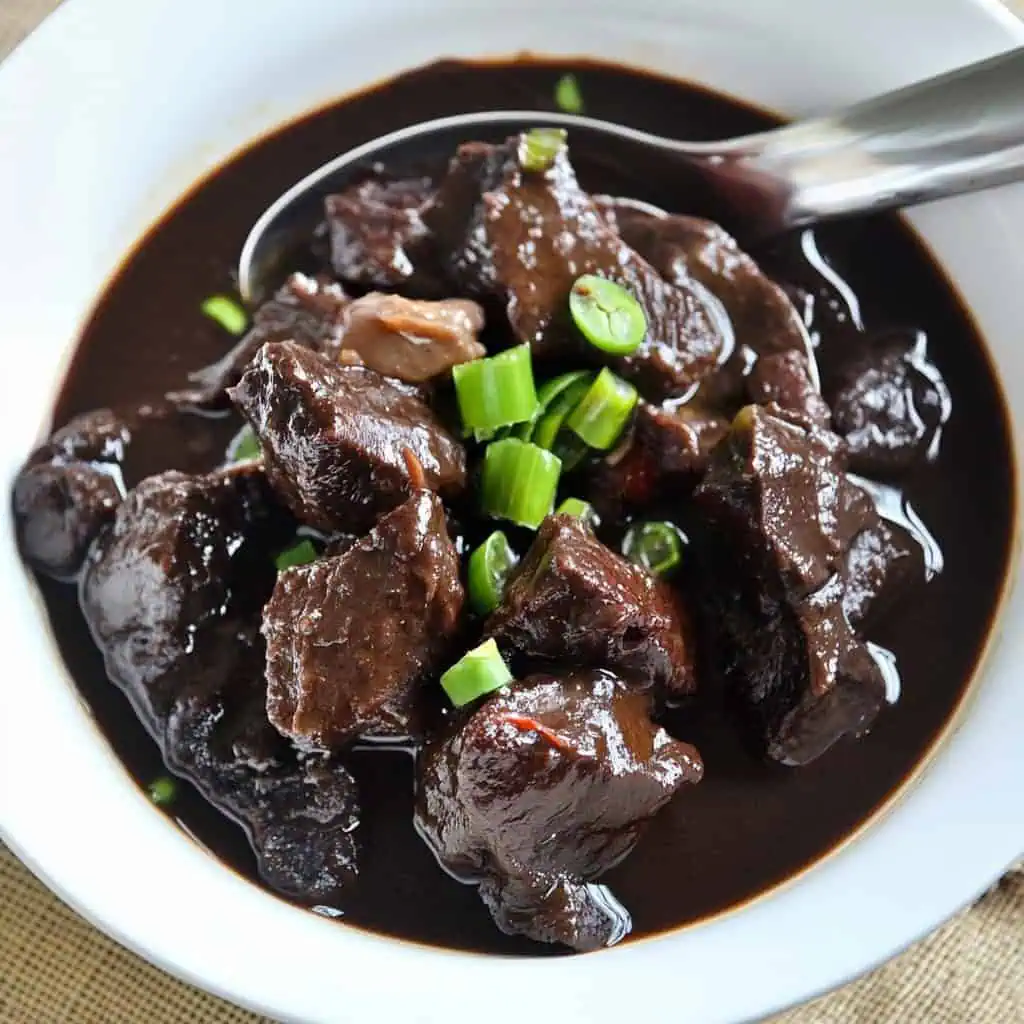
FAQ
Why is my dinuguan turning black instead of brown?
Too much blood or overcooked blood can cause this. Use the recommended ratio and keep heat low when adding blood.
Can I use chicken instead of pork?
Yes, chicken dinuguan (dinuguang manok) is popular in some regions. Use thigh meat for best results and reduce cooking time accordingly.
How do I know if the pork blood is fresh?
Fresh blood should be bright red, without clots, and have no strong odor. Always buy from reputable butchers who handle it properly.
Can I make it less spicy?
Yes, reduce or omit the chilies. The dish is traditionally mild to medium spicy, but heat level is customizable.
Is there a vegetarian version of dinuguan?
There are modern interpretations using mushrooms and tofu with black bean sauce or squid ink to mimic the color, but these are far from traditional.
How can I make dinuguan in advance for a party?
Prepare it 1-2 days ahead, refrigerate, and reheat slowly before serving. The flavors actually improve with time.
Why is vinegar so important in this dish?
Vinegar serves multiple purposes: it helps preserve the blood, balances its richness, adds tang, and acts as a natural preservative.
Can I use a pressure cooker or slow cooker for this recipe?
A pressure cooker can be used for tenderizing the meat before adding blood. For slow cookers, cook the meat base completely, then add blood mixture during the final 30 minutes on low heat.
Related
Looking for other recipes like this? Try these:
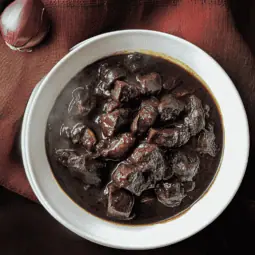
Authentic Filipino Dinuguan (Pork Blood Stew)
Ingredients
For the Stew Base:
- 2 pounds pork belly liempo, cut into ½-inch cubes
- 10 ounces fresh pork blood dugo ng baboy
- 1 cup vinegar suka
- 1 large onion sibuyas, finely chopped
- 4 cloves garlic bawang, minced
- 1 thumb-sized ginger luya, minced
- 1 tablespoon fish sauce patis
- 1 cup water tubig
- 1 tablespoon brown sugar asukal na pula
- 2-3 finger chilies/long green chilies siling haba
- Salt and pepper to taste
- 1 tablespoon cooking oil
Optional Traditional Additions:
- Pork ears tenga
- Intestines bituka
- Heart puso
- Kidney bato
Instructions
- Before starting, gather all your ingredients and equipment. Your pork blood should be fresh and kept cold at 40°F (4°C). (Siguraduhing sariwa ang dugo at nakalagay sa malamig.)
- Start by combining the fresh pork blood with 2 tablespoons of vinegar in a bowl. Mix gently and set aside in the refrigerator. (Paghaluin ang sariwang dugo at suka. Ilagay sa ref.)
- Place a large, heavy-bottomed pot over medium heat (300°F/149°C). Pour in the cooking oil. Once the oil is hot, add your finely chopped onions. Cook them until they become translucent and soft, about 5 minutes. (Igisa ang sibuyas)
- Add the minced garlic and ginger to the softened onions. Cook until you smell their fragrant aroma, about 2 minutes. Stir occasionally to prevent burning. (Igisa ang bawang at luya hanggang bumango.)
- Increase the heat to medium-high (325°F/163°C). Add your cubed pork belly to the pot. Cook the meat until it starts to brown on all sides, about 8-10 minutes. (Lutuin ang karne hanggang magbrown sa lahat ng gilid.)
- Pour in the fish sauce (patis) and cook for another 2 minutes, stirring to coat the meat evenly. (Ibuhos ang patis at haluing mabuti.)
- Now comes a critical step: Add the remaining vinegar to the pot. Once you add the vinegar, DO NOT STIR for 3-5 minutes. Let it boil to cook off the raw vinegar taste. (Ibuhos ang suka. HUWAG haluin ng 3-5 minuto.)
- After the vinegar has boiled, add one cup of water to the pot. Bring everything to a boil, then reduce the heat to low (185°F/85°C). Cover the pot and let it simmer for 20 minutes, or until the pork becomes tender. (Pakuluan ng mahina hanggang lumambot ang karne.)
- Remove your blood mixture from the refrigerator and let it come to room temperature. Once your meat is tender, slowly pour in the blood mixture while gently stirring. Keep the heat low and stir constantly but gently to prevent the blood from curdling. (Ibuhos ang dugo nang dahan-dahan habang hinahalo.)
- Add the brown sugar and finger chilies. Continue to simmer and stir gently for about 10 minutes, or until the sauce thickens to your desired consistency. (Lagyan ng asukal at sili. Pakuluan hanggang lumapot ang sarsa.)
- Taste your dinuguan and adjust the seasoning with salt and pepper as needed. The sauce should be smooth and velvety, with a balanced tangy and savory flavor. (Timplahan ng asin at paminta kung kinakailangan.)
- Your dinuguan is ready when the sauce is thick but still flows, the meat is tender but holds its shape, and the color is a rich chocolate brown. The internal temperature should reach 165°F/74°C. (Luto na ang dinuguan kapag malapot ang sarsa, malambot ang karne, at tsokolate brown ang kulay.)
- Serve your dinuguan hot with steamed rice or puto (rice cakes). For extra flavor, serve with calamansi on the side. (Ihain ng mainit kasama ng kanin o puto. Maaaring lagyan ng kalamansi.)
- If you have leftovers, let the dinuguan cool completely before transferring to an airtight container. Store in the refrigerator for up to three days. When reheating, use low heat and stir occasionally, adding a little water if needed to achieve the right consistency. (Palamiginin bago ilagay sa lalagyan. Maaaring itago sa ref ng hanggang tatlong araw.)
- For best results, use your dinuguan within the first two days when the flavors are at their peak. Remember that the sauce will continue to thicken as it cools, so you may need to thin it out slightly when reheating. (Mas masarap kainin sa loob ng dalawang araw. Maaaring lagyan ng kaunting tubig kapag iinit.)
Tips from Lola's Kitchen
- Always use fresh pork blood for best results
- Pre-mixing blood with vinegar prevents clumping
- Never skip the "no stirring" step after adding vinegar
- Keep the heat low when adding blood to prevent curdling
- If sauce is too thick, add water gradually while stirring
Nutrition
The Story Behind Dinuguan (Pork Blood Stew)
Dinuguan (from the word 'dugo' meaning blood) stands as one of the most intriguing and misunderstood dishes in Filipino cuisine. What makes this rich, dark stew remarkable isn't just its use of pork blood—a testament to our ancestors' "zero-waste" philosophy—but how it transforms what others might discard into a celebrated delicacy that has become a true marker of Filipino culinary courage. Often playfully called 'chocolate meat' to entice the uninitiated, dinuguan represents the Filipino talent for creating extraordinary flavors from humble ingredients.
The genius of dinuguan lies in its complex preparation, where the metallic taste of blood is masterfully balanced with vinegar, garlic, and chili peppers to create a velvety, tangy sauce that coats tender pieces of pork and offal. Its dark appearance might seem intimidating, but the dish showcases Filipino culinary wisdom—the vinegar not only balances flavors but also helps preserve the dish in tropical weather. Regional variations add their own twists: some versions are soup-like, others are thick and rich, while some areas add coconut milk for extra creaminess. But all versions share that distinctive tangy-savory profile that makes it the perfect partner for puto (rice cakes) or steaming rice.
Today, while some shy away from its authentic ingredients, dinuguan remains a proud symbol of Filipino food heritage, found at every fiesta and family gathering. It challenges both foreign and local diners to look beyond appearances and embrace the deep, complex flavors that make Filipino cuisine unique. Whether served in humble carinderias or upscale Filipino restaurants, dinuguan continues to prove that true culinary excellence often lies in preserving traditional practices and flavors.
Remember: Great dinuguan isn't just about the blood—it's about achieving that perfect balance of vinegar and spices, and that silky smooth sauce that marks the difference between a good cook and a master of Filipino cuisine.
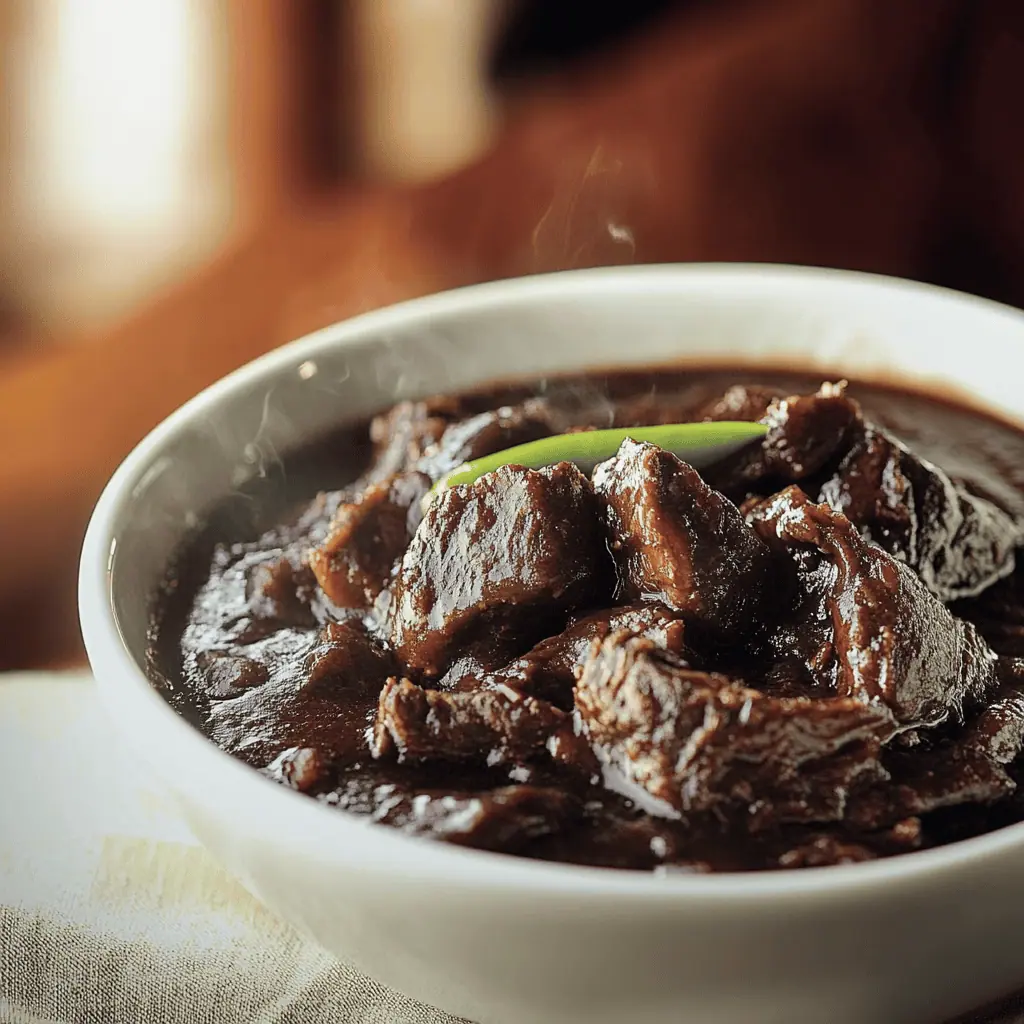

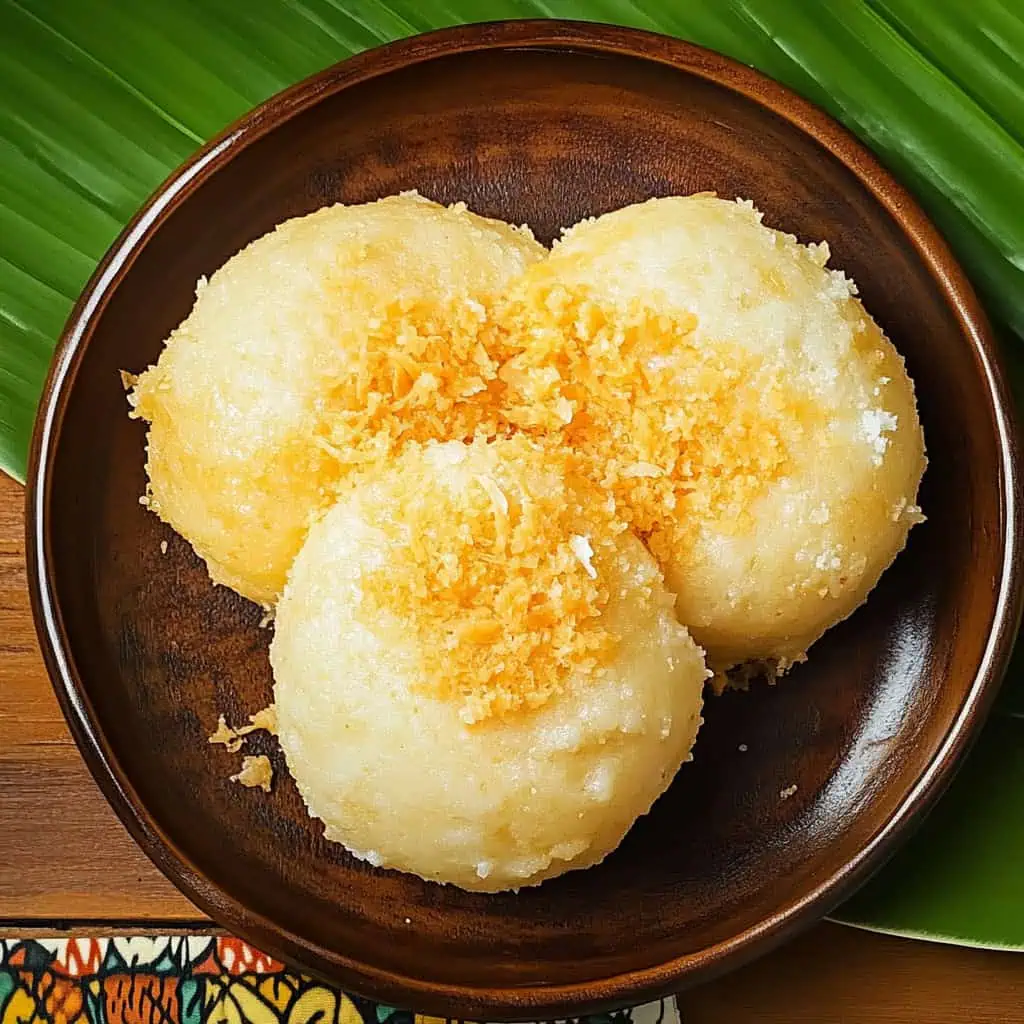
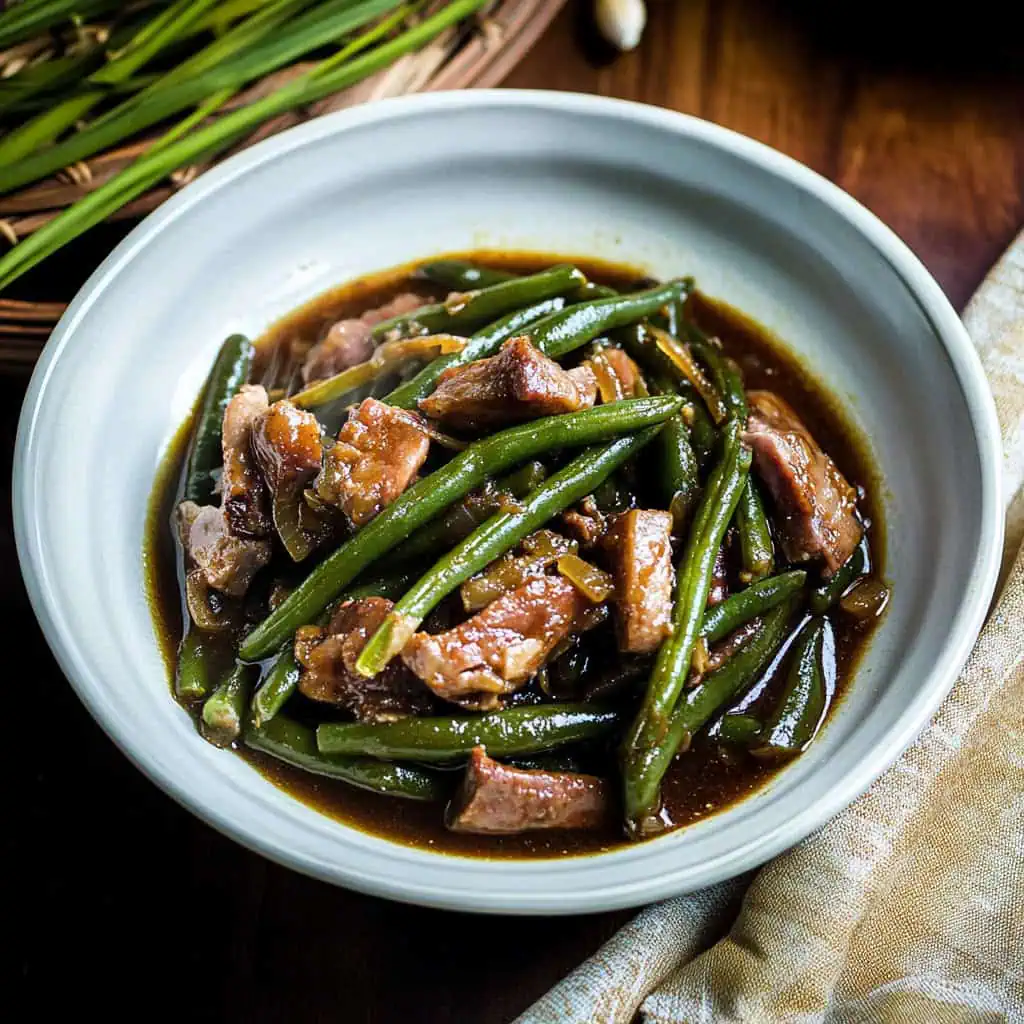

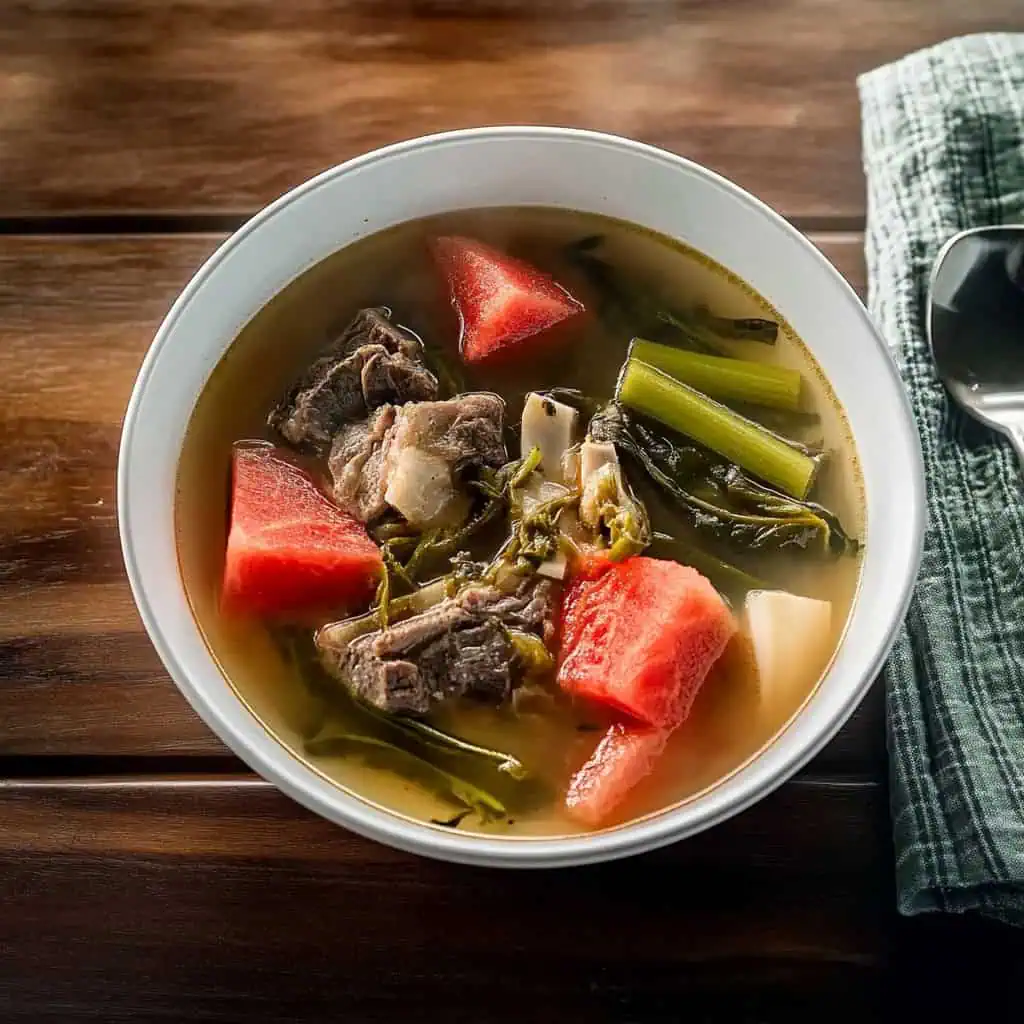




Comments
No Comments